

Compact Muon Solenoid
LHC, CERN
| CMS-SUS-14-021 ; CERN-PH-EP-2015-307 | ||
| Search for supersymmetry in events with soft leptons, low jet multiplicity, and missing transverse energy in proton-proton collisions at $\sqrt{s}= $ 8 TeV | ||
| CMS Collaboration | ||
| 25 December 2015 | ||
| Phys. Lett. B 759 (2016) 9 | ||
| Abstract: Results are presented from a search for supersymmetric particles in scenarios with a compressed mass spectrum. The data sample corresponds to 19.7 fb$^{-1}$ of proton-proton collisions recorded by the CMS experiment at $ \sqrt{s}= $ 8 TeV. The search targets top squark ($\mathrm{ \tilde{t} }$) pair production in scenarios with mass differences $\Delta m = m(\mathrm{ \tilde{t} }) - m(\tilde{\chi}_1^0)$ below the W-boson mass and with top-squark decays in the four-body mode ($\mathrm{ \tilde{t} } \to \mathrm{b}\ell\nu\tilde{\chi}_1^0$), where the neutralino ($\tilde{\chi}_1^0$) is assumed to be the lightest supersymmetric particle (LSP). The signature includes a high transverse momentum ($p_{\mathrm{T}}$) jet associated with initial-state radiation, one or two low-$p_{\mathrm{T}}$ leptons, and significant missing transverse energy. The event yields observed in data are consistent with the expected background contributions from standard model processes. Limits are set on the cross section for top squark pair production as a function of the $\mathrm{ \tilde{t} }$ and LSP masses. Assuming a 100% branching fraction for the four-body decay mode, top-squark masses below 316 GeV are excluded for $\Delta m = $ 25 GeV at 95% CL. The dilepton data are also interpreted under the assumption of chargino-neutralino production, with subsequent decays to sleptons or sneutrinos. Assuming a difference between the common $\tilde{\chi}_1^+/\tilde{\chi}_2^0$ mass and the LSP mass of 20 GeV and a $\tau$-enriched decay scenario, masses in the range $m(\tilde{\chi}_1^0) < $ 307 GeV are excluded at 95% CL. | ||
| Links: e-print arXiv:1512.08002 [hep-ex] (PDF) ; CDS record ; inSPIRE record ; CADI line (restricted) ; | ||
| Figures | |

png pdf |
Figure 1-a:
Signal models for top squark pair production with subsequent four-body decays (a), and chargino-neutralino pair production with decays via sleptons and sneutrinos (b). Antiparticle labels are suppressed. |
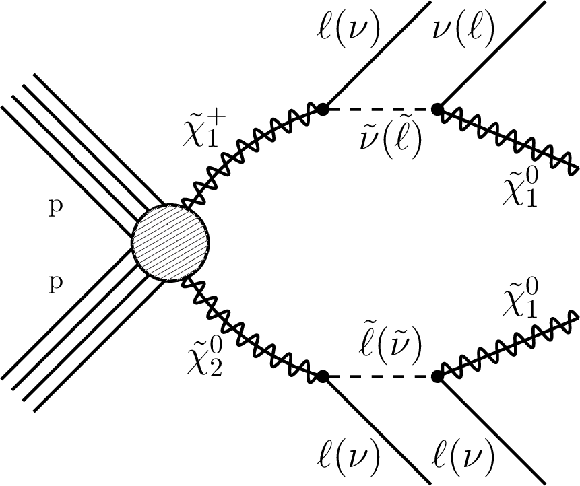
png pdf |
Figure 1-b:
Signal models for top squark pair production with subsequent four-body decays (a), and chargino-neutralino pair production with decays via sleptons and sneutrinos (b). Antiparticle labels are suppressed. |

png pdf |
Figure 2-a:
Distributions of (a) muon $ {p_{\mathrm {T}}} $ and (b ) $ {m_\mathrm {T}} $ after the preselection of the single-muon analysis. For each plot, the variable shown has been excluded from the selection. Data are indicated by circles. The uncorrected background predictions from simulation are represented as filled, stacked histograms, and the shapes for two signal points with $ {m(\mathrm{ \tilde{t} } )} = $ 225 GeV and mass splittings of $ {\Delta m} = $ 10 and 80 GeV as dashed red and solid blue lines, respectively. The error bars and the dark, shaded bands indicate the statistical uncertainties of data and simulation, respectively. The lower panels show the ratio of data to the sum of the SM backgrounds. |

png pdf |
Figure 2-b:
Distributions of (a) muon $ {p_{\mathrm {T}}} $ and (b ) $ {m_\mathrm {T}} $ after the preselection of the single-muon analysis. For each plot, the variable shown has been excluded from the selection. Data are indicated by circles. The uncorrected background predictions from simulation are represented as filled, stacked histograms, and the shapes for two signal points with $ {m(\mathrm{ \tilde{t} } )} = $ 225 GeV and mass splittings of $ {\Delta m} = $ 10 and 80 GeV as dashed red and solid blue lines, respectively. The error bars and the dark, shaded bands indicate the statistical uncertainties of data and simulation, respectively. The lower panels show the ratio of data to the sum of the SM backgrounds. |
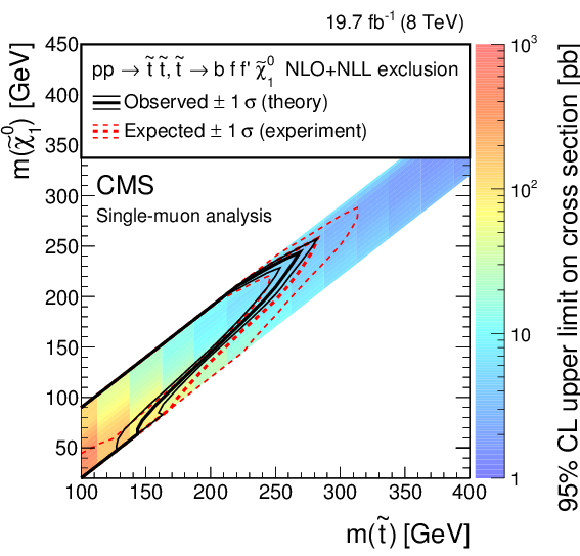
png pdf |
Figure 3-a:
Cross section and mass limits at 95% CL in the $ {m(\tilde{\chi}_1^0 )} $ and $ {m(\mathrm{ \tilde{t} } )} $ mass plane for the (a) single-muon and (b) dilepton searches. The colour shading corresponds to the observed limit on the cross section. The solid (dashed) lines show the observed (expected) mass limits, with the thick lines representing the central value and the thin lines the variations due to the theoretical (experimental) uncertainties. |

png pdf |
Figure 3-b:
Cross section and mass limits at 95% CL in the $ {m(\tilde{\chi}_1^0 )} $ and $ {m(\mathrm{ \tilde{t} } )} $ mass plane for the (a) single-muon and (b) dilepton searches. The colour shading corresponds to the observed limit on the cross section. The solid (dashed) lines show the observed (expected) mass limits, with the thick lines representing the central value and the thin lines the variations due to the theoretical (experimental) uncertainties. |

png pdf |
Figure 4:
Cross section limits at 95% CL obtained from the search in the dilepton channel as a function of the common $ \tilde{\chi}_1^{\pm} / \tilde{\chi}_1^0 $ mass. The black lines with symbols correspond to the observed limit, while the solid and dashed coloured lines represent the expected limit and the ${\pm }1\sigma $ bands corresponding to the experimental uncertainties, respectively. The flavour-democratic ($\tau $-enriched) cases of the model are indicated by green (orange) lines and upward- (downward-) pointing triangular symbols. The solid and dashed blue lines without symbols correspond to the predicted cross section for chargino-neutralino production and its uncertainties. |
| Tables | |

png pdf |
Table 1:
Definition of signal and control regions for the single-muon search. For jets, the attributes ``soft'' and ``hard'' refer to the $ {p_{\mathrm {T}}} $ ranges 30--60 GeV and $>$ 60 GeV, respectively. For the calculation of the final results, each signal region (SRSL1a--c, SRSL2) is subdivided into three bins according to $ {p_{\mathrm {T}}} (\mu )$: 5--12, 12--20, and 20--30 GeV . |

png pdf |
Table 2:
Contributions to the control regions of the single-muon analysis as determined from simulation, together with the observed event counts. All uncertainties are statistical. |

png pdf |
Table 3:
Estimated background contributions for the signal regions of the single-muon analysis. For the signal samples, ${m(\mathrm{ \tilde{t} } )} $ and $ {m(\tilde{\chi}_1^0 )} $ are shown in parentheses. All uncertainties are statistical. |
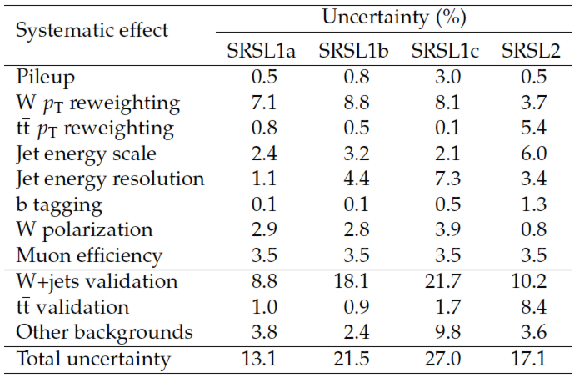
png pdf |
Table 4:
Relative systematic uncertainties in the background predictions in the signal regions of the single-muon search. |
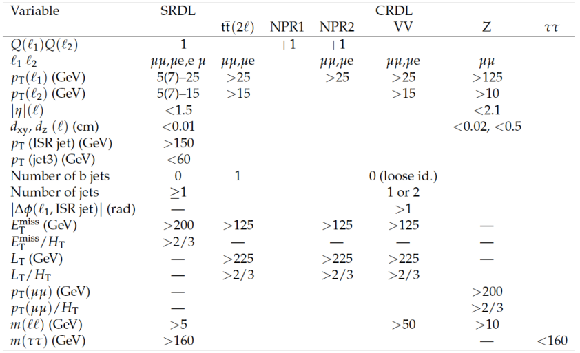
png pdf |
Table 5:
Definition of signal and control regions for the dilepton search. For the CRs, only changes with respect to the SR are shown. Dashes indicate that no selection is applied. For the lower limits on lepton $ {p_{\mathrm {T}}} $ in the SR, the value used for electrons is shown in parentheses. The SR is subdivided into two bins according to the $ {p_{\mathrm {T}}} $ of the leading lepton: 5--15 and 15--25 GeV . |

png pdf |
Table 6:
Contributions to the control regions of the dilepton analysis as expected from simulation, together with the observed event counts. All uncertainties are statistical. |
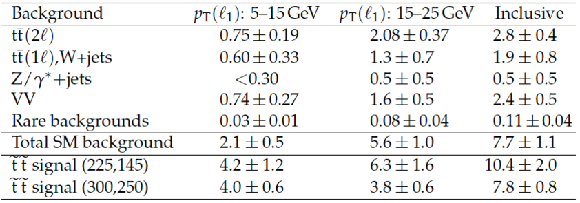
png pdf |
Table 7:
Estimated background contributions for the two signal regions of the dilepton search. For the signal samples, $ {m(\mathrm{ \tilde{t} } )} $ and $ {m(\tilde{\chi}_1^0 )} $ are shown in parentheses. |
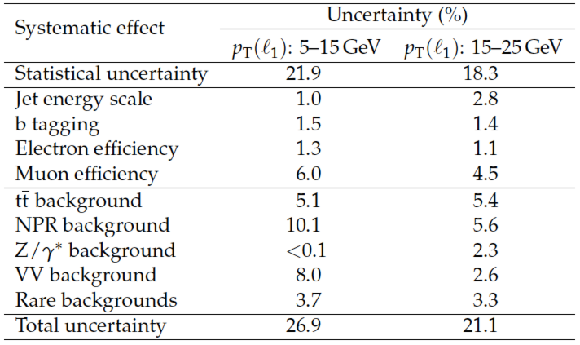
png pdf |
Table 8:
Relative systematic uncertainties in the background predictions in the signal regions of the dilepton search. |

png pdf |
Table 9:
Summary of observed and expected background yields in the signal regions of the single-lepton and dilepton searches. The uncertainties in the background yields include statistical and systematic contributions. Transverse momenta are shown in units of GeV. |
| Summary |
|
A search for supersymmetry with compressed mass spectra is performed in events with soft leptons, moderate to high values of $ E_{\mathrm{T}}^{\rm{miss}} $, and one or two hard jets, compatible with the emission of initial-state radiation. The data sample corresponds to 19.7 fb$^{-1}$ of proton-proton collisions recorded by the CMS experiment at $\sqrt{s} = $ 8 TeV. Two event categories are considered: events with a single, soft muon and events in which a second, soft electron or muon is present. The first target of this search is the pair production of top squarks with a mass splitting of at most 80 GeV with respect to the LSP. At low mass splitting, lepton momenta are low, and the b jets do not enter the acceptance. At higher values of $ \Delta m$, the average lepton momentum increases and soft b jets can be reconstructed. Therefore, signal regions are further divided according to the $ p_{\mathrm{T}} $ of the leading lepton and the presence or absence of a soft b-tagged jet. In the single-lepton search the transverse mass of the lepton-$ E_{\mathrm{T}}^{\rm{miss}} $ system is used as an additional discriminant. The main backgrounds to this search are W+jets and $ \mathrm{ t \bar{t} } $ production. Contributions to the signal regions from these and several nonleading background sources are estimated by using data in control regions to normalize the simulated yields. These estimates are tested with data in validation regions. The observations in the signal regions are compatible with the SM background predictions. In the absence of any indication of signal, cross section limits are set at 95% CL in the $\tilde{ \mathrm{t} } $--$ \tilde{ \chi }_1^0 $ mass plane. These results are used to extract mass limits based on a reference cross section for top squark pair production and assuming a 100% branching fraction for the four-body decay $\tilde{ \mathrm{t} } \to \mathrm{ b f f^{\prime} } \tilde{ \chi }_1^0 $. The most stringent limit on the mass of the top squark is obtained in the dilepton channel: $m(\tilde{ \mathrm{t} } ) >$ 316 GeV at 95% CL for a mass splitting of 25 GeV. These results extend existing limits in the four-body decay channel of the top squark [17,18] and complement the analyses performed in the $ \tilde{ \mathrm{t} } \to \mathrm{c} \tilde{ \chi }_1^0 $ channel [16]. The results obtained in the dilepton channel are also used to set limits on models of chargino-neutralino production in a compressed spectrum with a mass difference between $\tilde{\chi}_1^+/\tilde{\chi}_2^0$ and $ \tilde{ \chi }_1^0 $ of 20 GeV. Based on the 95% CL upper limit on the cross section in the case of flavour-democratic leptonic decays of these particles, a lower limit on the common $ \tilde{\chi}_1^+/\tilde{\chi}_2^0 $ mass is set at 212 GeV. If chargino decays proceed exclusively via the $\tau$ channel, and in the absence of the $\tilde{\chi}_2^0 \to \tilde{ \nu} \nu$ decay mode, this limit increases to 307 GeV, well above existing limits [22]. |

|
Compact Muon Solenoid LHC, CERN |

|

|

|

|

|

|